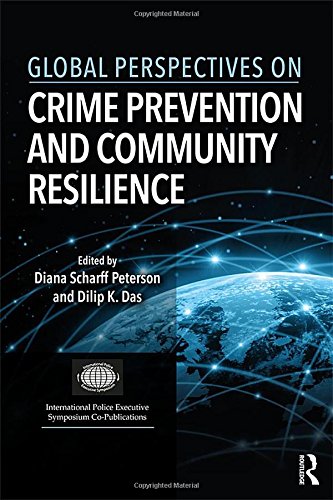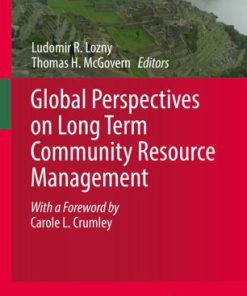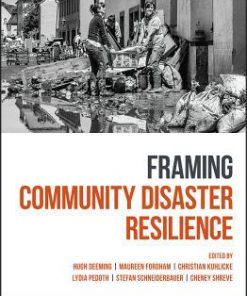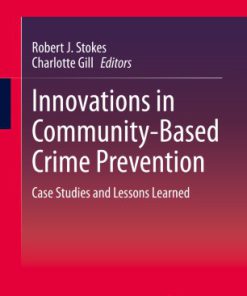Global Perspectives on Crime Prevention and Community Resilience 1st Edition by Diana Scharff Peterson 1315351476 9781315351476
$50.00 Original price was: $50.00.$25.00Current price is: $25.00.
Global Perspectives on Crime Prevention and Community Resilience 1st Edition by Diana Scharff Peterson – Ebook PDF Instant Download/DeliveryISBN: 1315351476, 9781315351476
Full download Global Perspectives on Crime Prevention and Community Resilience 1st Edition after payment.

Product details:
ISBN-10 : 1315351476
ISBN-13 : 9781315351476
Author: Diana Scharff Peterson
Inspired by the dialogue between practitioners and academics of nearly thirty countries, this edited volume includes updated articles on global crime prevention initiatives and best practices in building community resilience presented at the International Police Executive Symposium’s (IPES) 25th annual meeting in Sofia, Bulgaria in 2014. A new book in the highly-regarded IPES Co-Publications series, Global Perspectives on Crime Prevention and Community Resilience offers strategies for crime and violence prevention and community initiatives for crime reduction, while promoting current best practices for police effectiveness, safety, and professionalism. The book includes eighteen chapters from police leaders, practitioners and academics around the world in efforts to demonstrate effective strategies for the prevention of crime and innovative techniques in assisting crime victims. In an increasingly global reality, this text gives voice to valuable members of the international policing community.
Global Perspectives on Crime Prevention and Community Resilience 1st Table of contents:
1 Coordinated Community Response to Domestic Violence and Sexual Assault on the College Campus
Literature Review
Office on Violence against Women Minimum Standards
Violence Prevention and Intervention Program
The Emergence of Title IX
The Campus SaVE Act of 2013
How Recent Legal Developments Have Impacted the CCRT at ULM
References
2 Different Communities, Different Approaches: Avoiding a ‘One Size Fits All’ Approach to Neighbourhood Policing Strategies
Introduction
Methodology Overview
Results
The New Framework of Public Confidence in York
Testing the Homogeneity of the New Framework of Public Confidence in York
Conclusion
Acknowledgements
Notes
References
3 Community-Based Participatory Approach to Prevent Residential Burglaries and House Robberies
Methodology
Results
Conclusion
References
4 Crossing the Great Divide: The Development and Effectiveness of Working Relationships between Law Enforcement Personnel and Academic Researchers
Orange County, Florida
The Development of the Relationship
The Mayor’s Safe Orlando Task Force
Violent Crime in Orange County
Orange County Violent Crime Statistics
Homicide in Orlando
Orlando Homicide Victim and Suspect Characteristics
Weapons, Motives, and Dispositions: Orlando Homicides
Orange County Gang Activity
Demographics for Gang Members Booked for Violent Crimes
Violent Crimes for which Gang Members Are Booked
A Curfew: Are You Kidding?
Juvenile and Adult Victim Characteristics
Juvenile Suspects Involved in Robbery by Time of Day
Summary
Appendix 4.1: Safe Orlando Task Force Members
Appendix 4.2: Mayor’s Safe Orlando Task Force Recommendations
Prevention Subcommittee
Re-Integration Subcommittee
References
5 The B3W Matrix: Managing a More Effective Way to Tackle Residential Burglary
Introduction
Method
The B3W Matrix
The B3W Scale (Max. 10 Points)
Self-Evaluation
Findings
Quality of the Approach
Effects of B3W: An Initial Impression
Success Factors
Improvement of the Approach
Conclusions
References
6 Managing Language Barriers in Policing
Introduction
Significance of Communication
Communicating with Diverse Communities in Australia
A Case Study on Communication Preference
Research Study
Findings and Discussion
Conclusion
Limitations of Study
References
7 Community Policing and Vigilantism: Two Alternative Strategies for Fighting Neighborhood Crime
Community Justice, Informal Justice, and Popular Justice
Community Policing Strategy
A Significant Example of Community-Based Policing
The Phenomenology of Vigilantism
Conclusion
References
8 Policing in Remote Australia: Is it Possible to Ignore Colonial Borderlines?
Introduction
The Region
The Birth of an Idea
The Challenges
The Evaluation
Analysis
Conclusion
Note
References
9 Multi-Sector Co-Operation in Preventing Crime: The Case of a South African Neighbourhood Watch as an Effective Crime Prevention Model
Introduction
Hunter’s Private, Parochial, and Public Social Orders
Carr’s ‘New Parochialism’
Neighbourhood Organizations as Facilitators of Resident–Police
Methodology
Brief History of Community Policing in South Africa
Background and Development of the RNW
Relationship and Co-Operation Between the Police and the RNW in
Relationship and Co-Operation Between the RNW and Private Security
Relationship and Co-Operation Between the RNW and Local Businesses in
Conclusion
Note
References
10 Human Trafficking: A Global Examination of Sexual Exploitation, Corruption, and Future Implications
Human Trafficking: A Global Examination of Perspectives, Policy, and Application
Literature Review
Future Implications
Conclusion
References
11 Building Community Resilience: Strategic Role of Police with Bombing Victims
Introduction
Terrorism as an Act of Crime Based on Ideology
Challenges in Treating Bombing Victims
Strategic Role of Police in Transforming Victims into Champions
Stage I: Physical Rehabilitation
Stage II: Psychosocial Rehabilitation
Stage III: Harmonization Through Group Therapies and Dialogues
Stage IV: Empowerment Programs
Stage V: Generating Change Agents
Conclusion
Note
References
12 Women in Law Enforcement: Reality or Myth?
Introduction
International Historical Outline
South African State of Affairs
Method
Quantitative Data Analysis Strategy
Results
Qualitative Collection and Analysis Strategies
Results
Myths Pertaining to Female Police Officials
Concluding Thoughts
References
13 Strategies in Prevention of Crime against Women in India – with Special Reference to Telangana State
Introduction
Women’s Status in India
Causes of Violence
Legal Safeguards
Crime against Women in India
Types of Violence
Growth of Violence against Women
Administrative Measures of Governments
Conclusion
Suggestions
Notes
References
14 The Assessment of Capable Guardianship Measures Against Bullying Victimization in the School Environment
Introduction
Theoretical Framework and Literature Review
Methodology
Analysis and Findings
Discussion
Conclusion
Appendix 14.1: Interview Questions
References
15 An Analysis of the Effects of On-Body Officer Camera Systems
Introduction
Resistance to New Technology
Methodology
Stakeholders and Workgroup
Program Administration
Study Protocol
Results
Axon Users: Differences Between Volunteer and Assigned Users
Complaints
Redaction Requests
Limitations and Lessons Learned
Program Management
Hardware
Policy Evaluation
Notes
References
16 Information Sharing in the Investigative Units of Local Law Enforcement Agencies: Which Units Share Information and Why?
Introduction
Information Management in Policing
Information Sharing in the Era of Homeland Security
Impediments to Information Sharing
Factors Associated with Information Sharing
Method
Dependent Variables
Independent Variables
Results
Study Limitations
Conclusion
Notes
References
17 Retention Factors in Relation to Organizational Commitment: Empirical Evidence from the Ghana Police Service
Introduction
Literature Review
Methods
Results
Discussion
Conclusion
References
18 Safety Management and Performance-Based Management – an Excellent Match
Introduction
Effects of Supervision and Control
COMPSTAT
Organizing Counterforce
Management Model
Police Vision: From Policy to Performance
Management Cycle: Performance-Based Management and Safety Management
Reputation Management
People also search for Global Perspectives on Crime Prevention and Community Resilience 1st:
global perspectives perspectives
global perspective of crime
global perspective on climate change
global perspectives project
global perspectives on threat intelligence report
Tags: Global Perspectives, Crime Prevention, Community Resilience, Diana Scharff Peterson
You may also like…
Politics & Philosophy
Politics & Philosophy - Politics
Jurisprudence & Law - Criminal Law & Procedure
Education Studies & Teaching
Medicine - Others
Sports Injuries; Prevention, Treatment and Rehabilitation; Fifth Edition Lars Peterson
Biography & Autobiography - Social & Health Issues
Global Perspectives on Long Term Community Resource Management Ludomir 3030158004 9783030158002
Science (General)
Politics & Philosophy - Social Sciences
Innovations in Community Based Crime Prevention Case Studies and Lessons Learned Robert J. Stokes












